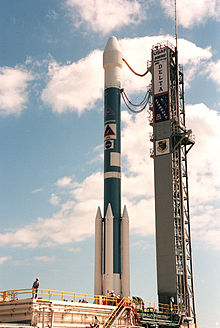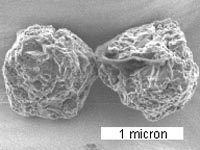Presolar grains

Presolar grains are interstellar solid matter in the form of tiny solid grains that originated at a time before the Sun was formed. Presolar stardust grains formed within outflowing and cooling gases from earlier presolar stars.
The
Terminology
This section may be confusing or unclear to readers. (January 2020) |
Meteoriticists often use the term to represent stardust, grains that originated within a single star and which they extract from meteorites for study. Because most interstellar grains are not stardust from a single star, however, being instead interstellar cloud matter accreted by smaller presolar grains, most presolar grains are also not stardust. Logically, all stardust are presolar grains; but not all presolar grains are stardust. This confusing terminology is heavily entrenched among 21st century meteoriticists who prefer to use the terms interchangeably, however, so both usages should employ or utilize the expression presolar stardust grains for stardust.
History
In the 1960s, the noble gases
A new theoretical framework for interpretation was advanced during the 1970s when Donald D. Clayton rejected the popular belief among meteoriticists that the solar system began as a uniform hot gas.[7] Instead he predicted that unusual but predictable isotopic compositions would be found within thermally condensed interstellar grains that had condensed during mass loss from stars of differing types. He argued that such grains exist throughout the interstellar medium.[7][8] Clayton's first papers using that idea in 1975 pictured an interstellar medium populated with supernova grains that are rich in the radiogenic isotopes of Ne and Xe that had defined the extinct radioactivities.[9] Clayton defined several types of stardust presolar grains likely to be discovered: stardust from red giant stars, sunocons (acronym from SUperNOva CONdensates) from supernovae, nebcons from nebular condensation by accretion of cold cloud gaseous atoms and molecules, and novacons from nova condensation.[7] Despite vigorous and continuous active development of this picture, Clayton's suggestions lay unsupported by others for a decade until such grains were discovered within meteorites.
The first unambiguous consequence of the existence of stardust within meteorites came from the laboratory of Edward Anders in Chicago,[10] who found using traditional mass spectrometry that the xenon isotopic abundances contained within an acid-insoluble carbonaceous residue that remained after the meteorite bulk had been dissolved in acids matched almost exactly the predictions for isotopic xenon in red giant stardust.[8] It then seemed certain that stardust grains were contained within Anders' acid-insoluble residue. Finding the actual stardust grains and documenting them was a much harder challenge that required locating the grains and showing that their isotopes matched those within the red-giant star. There followed a decade of intense experimental searching in the attempt to isolate individual grains of those xenon carriers. But what was really needed to discover stardust was a new type of mass spectrometer that could measure the smaller number of atoms in a single grain. Sputtering ion probes were pursued by several laboratories in the attempt to demonstrate such an instrument. But the contemporary ion probes needed to be technologically much better.
In 1987 diamond grains[11] and silicon carbide grains[12] were found to exist abundantly in those same acid-insoluble residues and also to contain large concentrations of noble gases. Significant isotopic anomalies were in turn measured by improvements in secondary ion mass spectrometry (SIMS) within the structural chemical elements of these grains.[13] Improved SIMS experiments showed that the silicon isotopes within each SiC grain did not have solar isotopic ratios but rather those expected in certain red-giant stars. The finding of stardust is therefore dated 1987.[12] To measure the isotopic abundance ratios of the structural elements (e.g. silicon in an SiC grain) in microscopic stardust grains had required two difficult technological and scientific steps: 1) locating micron-sized stardust grains within the meteorite's overwhelming mass; 2) development of SIMS technology to a sufficiently high level to measure isotopic abundance ratios within micron-sized grains. Ernst Zinner became an important leader in SIMS applications to microscopic grains.[14][15]

In January 2020, analysis of the Murchison meteorite found in Australia in 1969 revealed that its stardust formed 5 to 7 billion years ago, older than Earth's 4.6 billion year-old sun, making the meteor and its stardust the oldest solid material ever discovered on Earth.[16][17][18]
In meteorites
Presolar grains are the solid matter that was contained in the interstellar gas before the Sun formed. The stardust component can be identified in the laboratory by their abnormal isotopic abundances and consists of refractory minerals which survived the collapse of the solar nebula and the subsequent formation of planetesimals.[19]
To meteorite researchers, the term presolar grains has come to mean presolar grains found in meteorites, which consist overwhelmingly of
Characterization
Presolar grains are investigated using scanning or transmission
Presolar grains consisting of the following minerals have so far been identified:
- diamond (C) nanometer-sized grains (~2.6 nanometres (1⁄10000000 in) diameter)[21] possibly formed by vapor deposition[22]
- graphite (C) particles and anions,[23] some with unlayered graphene cores[24]
- silicon carbide (SiC) submicrometer to micrometer sized grains. Presolar SiC occurs as single-polytype grains or polytype intergrowths. The atomic structures observed contain the two lowest order polytypes: hexagonal 2H and cubic 3C (with varying degrees of stacking fault disorder) as well as 1-dimensionally disordered SiC grains.[25] In comparison, SiC synthesized in terrestrial laboratories is known to form over a hundred polytypes.
- titanium carbide (TiC) and other carbides within C and SiC grains[26]
- silicon nitride (Si3N4)
- corundum (Al2O3)[27]
- spinel (MgAl2O4)[28]
- hibonite ((Ca,Ce)(Al,Ti,Mg)12O19)[29]
- titanium oxide (TiO2)
- silicate minerals (olivine and pyroxene)
Information on stellar evolution
The study of presolar grains provides information about nucleosynthesis and stellar evolution.[3] Grains bearing the isotopic signature of "r-process" (rapid neutron capture) and alpha process (alpha capture) types of nucleosynthesis are useful in testing models of supernova explosions.[30]
For example, some presolar grains (supernova grains) have very large excesses of
Other presolar grains (AGB star grains) provide isotopic and physical information on asymptotic giant branch stars, which have manufactured the largest portion of the refractory elements lighter than iron in the galaxy. Because the elements in these particles were made at different times (and places) in the early Milky Way, the set of collected particles further provides insight into galactic evolution prior to the formation of the Solar System.[32]
In addition to providing information on nucleosynthesis of the grain's elements, solid grains provide information on the physico-chemical conditions under which they condensed, and on events subsequent to their formation. [32] For example, consider red giants — which produce much of the carbon in our galaxy. Their atmospheres are cool enough for condensation processes to take place, resulting in the precipitation of solid particles (i.e., multiple atom agglomerations of elements such as carbon) in their atmosphere. This is unlike the atmosphere of the Sun, which is too hot to allow atoms to build up into more complex molecules. These solid fragments of matter are then injected into the interstellar medium by radiation pressure. Hence, particles bearing the signature of stellar nucleosynthesis provide information on (i) condensation processes in red giant atmospheres, (ii) radiation and heating processes in the interstellar medium, and (iii) the types of particles that carried the elements of which we are made, across the galaxy to our Solar System.[33]
See also
References
- .
- doi:10.1063/1.882049.
- ^ .
- .
- .
- ^ Xenon has nine stable isotopes that differ in mass because they have different numbers of neutrons in their atomic nuclei. The mass spectrometer records the number of detected xenon atoms at atomic weights A=124, 126, 128, 129, 130, 131, 132, 134, and 136. By measuring these at several temperature steps in the heating of the sample it was demonstrated that trapped xenon had differing components within its total. It was speculated that one such component was xenon created when an unknown superheavy nucleus that was assumed to exist in the early Solar System underwent fission.
- ^ S2CID 121956963.
- ^ doi:10.1086/156449. This paper was submitted in 1975 to Geochim. et Cosmochim Acta but was judged at that time to not be relevant to geochemistry. It was resubmitted to Astrophys J in 1978 after Edward Anders stated that he had discovered the pure s-process xenon gas in a bulk carbonaceous residue off a meteorite.
- doi:10.1086/153750.
- S2CID 21175338.
- S2CID 4324489.
- ^ S2CID 4361807.
- S2CID 32074812.
- . A special issue of Meteoritics and Planetary Science documents Zinner's role in honor of his 70th birthday.
- . Zinner died in 2015 at age 78. His obituary in February 2016 Physics Today by Donald Clayton tells more of Zinner's relationship to SIMS discoveries.
- ^ Strickland, Ashley (13 January 2020). "The oldest material on Earth has been found in a meteorite". CNN.
- ^ Weisberger, Mindy (13 January 2020). "7 Billion-Year-Old Stardust Is Oldest Material Found on Earth - Some of these ancient grains are billions of years older than our sun". Live Science. Retrieved 13 January 2020.
- PMID 31932423.
- ISBN 978-981-256-099-5.
- ^ a b Temming, Maria (13 January 2020). "This ancient stardust is the oldest ever to be examined in a lab". Science News. Retrieved 14 January 2020.
- .
- .
- S2CID 55542326.
- S2CID 15066112.
- S2CID 208322.
- doi:10.1086/186054.
- doi:10.1086/187319.
- .
- .
- ^ "Oldest material on Earth discovered". bbc.co.uk. 13 January 2020. Retrieved 14 January 2020.
- ISBN 978-0-521-87862-3.
- ^ a b Bennett, Jay (January 13, 2020). "Meteorite Grains Are the Oldest Known Solid Material on Earth". Smithsonian Magazine. Retrieved 14 January 2020.
- ^ Starr, Michelle (January 13, 2020). "The Oldest Known Material on Earth Is Officially Older Than The Solar System". sciencealert.com. Retrieved 14 January 2020.
